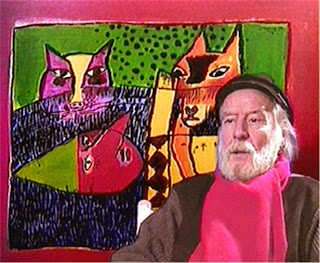Made by a student of grade 3
You need:- drawing sheet A3 size
- oil pastels
- liquid watercolor paint
- brushes
Show Corneille paintings on the digital board or use google: 'Corneille woman cat'.
Who of you has a cat at home? Does it ever lie with you? Does your cat ever lie on your head?
Look at these artworks. What do you see? Why would the painter left the cat's eyes white? Do the women on the paintings have hair?
Draw a head on your sheet with oilpastel (dark color). Maybe your own head, but you may choose another head too. Draw a cat sitting, standing or lying down on the head. The cat looks like hair! What hairstyle it is, had to do with the position of the cat.
Color your drawing with bright colors. Trace the outlines with a dark color if necessary and paint the background with liquid watercolor paint.
Made by a student of grade 3
There are more lessons about Corneille on this blog! Use the search function.





.jpg)
.jpg)
.jpg)
.jpg)
.jpg)

.jpg)
.jpg)
